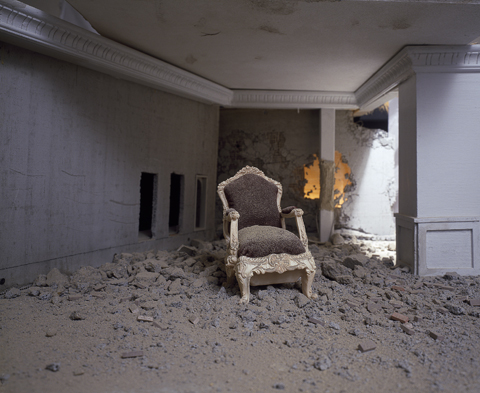
A MIRAGE OF TRUTH An image from Bilal's 'Ashes' series. |
That damned Iraq war. Of course the weapons of mass destruction proved to be bullshit. And the Bush Administration dicks (Cheneys) let the whole misbegotten failure spiral out of control. Because they were arrogant and incompetent and cruel. Ten years and nearly 5000 coalition deaths and more than 100,000 (by the lowest estimates) Iraqi deaths later, we're (sorta) out of there, but the bombs still blast and people still die. It's all ruins.
From those ruins emerges Wafaa Bilal's "The Ashes Series" and Daniel Heyman's "I Am Sorry It Is So Difficult To Start," on view at Brown University's Bell Gallery (64 College St, Providence, through May 26).
Bilal is an Iraqi-born artist, now teaching in New York, whose brother was killed in Iraq during the war. He's best known for his 2007 piece Domestic Tension, in which he spent a month in Chicago's Flatfile Gallery in range of a paintball gun that visitors and online viewers could fire at him. By his account, more than 65,000 shots were fired. It spotlighted the aggression roiling through the world, and its innocent victims.
Bilal's "Ashes" photos are quieter. At first, the images feel both real and somehow off. It turns out that in 2003 Bilal began collecting news photos of blasted sites in Iraq and recreating them as miniature models, which he then reproduces in photos. He depicts a street scattered with papers, a chandelier hanging from a ceiling with a gaping hole, an unmade bed in an ornate but dusty room, a grand piano flopped to the floor amidst chunks of concrete.
Each scene was sprinkled with "21 grams of human ashes . . . referencing the mythical weight of the human soul," curator Ian Alden Russell reports. Here Russell hangs the pictures on the far sides of 10 columns, which gives the gallery the feel of a crypt.
Some of the photos might feel familiar, like a shot of a fancy upholstered chair sitting in a pile of rubble inside a large gray room. It's based on a widely reproduced photo that Robert Nickelsberg took inside one of Saddam Hussein's ruined palaces while embedded with Marines in April 2003. Bilal's version has less rubble, is simplified, but still conveys the haunted feeling of places destroyed by violence and emptied of people.
"These images exist in the aftermath of atrocity," Bilal writes. "These images also serve as mirrors to my desire to return home to Iraq when this is not possible." The photos seem ultimately about Bilal trying to reconcile memories of his homeland and news pictures of what it became. In the act of physically recreating these various truths, he builds a kind of mirage.